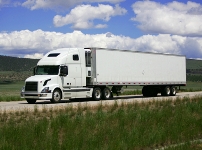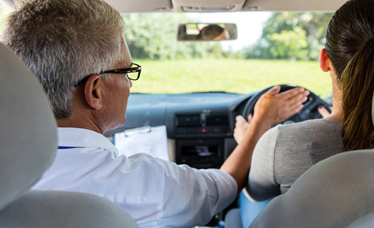Chapter 6 – Section 1
Safe Passing Techniques
Safe passing requires rapid decision-making and good judgment. Jason Kidd is one of the best passing point guards in basketball. Passing other vehicles on the road is often a dangerous maneuver. Visibility and vehicle responsiveness, among other things, are essential.
It is unsafe and against the law to pass another vehicle using the left side of the roadway if your view of the roadway is obstructed or the lane is not free of oncoming traffic that is far enough away for you to pass safely. It is also unsafe and illegal to pass on bridges or in underpasses or tunnels, or when approaching within 100 feet of or traversing any intersection or railroad grade crossing.
You may pass on the right side if the vehicle you are passing is making or about to make a left turn, upon a highway (with two or more lanes), within a business or residential district with unobstructed pavement of sufficient width for two or more lanes of moving vehicles in the direction of travel, or on a one-way street.
In no instance should a vehicle be driven off the paved or main roadway. It is illegal to pass on the right shoulder of the road.1
You can use the left side of the road to pass another vehicle under these conditions:
- Passing is legal when there is a broken line on your side of the road or when there is a single white broken line in the middle of a two-lane road.
- Pass only when the maneuver is perceived as safe and prudent and can be completed without use of excessive speed. The pass must be completed within a reasonable amount of time, and you cannot exceed the speed limit.
-

Pass only if you have enough room to return to your lane.
Remember these passing tips:
- Avoid passing on two-lane roads, as you will be driving into oncoming traffic.
- Check traffic conditions ahead, as you will need a 10 to 12 second gap in oncoming traffic to pass safely.
- Always signal when beginning and ending the pass.
- Pass only if you have enough room to return to your lane.
- Before you reenter your lane after passing, make sure you can see both headlights of the car behind you to ensure you have enough room.
- Do not pass more than one vehicle at a time.
-
A. Passing on Mountain Roads
-
Yield the right-of-way accordingly when driving on mountain roads.Fatal collisions often occur when passing is attempted on a mountain road. It is against the law to pass to the left on a mountain road, when approaching or upon the crest of a grade or curve of a highway, or where your view is obstructed within such distance as to create a hazard if another vehicle approaches from the opposite direction.
Additionally, you should not pass another vehicle on a grade unless you are traveling at least 10 mph faster than the overtaken vehicle (without exceeding the speed limit), or unless the maneuver can be completed within a safe distance, usually not greater than a 1/4 mile.
When driving on mountain roads, be aware of the potential for vehicle overheating or brake failure, the need for proper gear choices, and the need for lower speeds. A vehicle operated at high altitudes is prone to overheating and vapor lock. A vapor lock is a pocket of vaporized gasoline in the fuel line of an internal-combustion engine that obstructs the normal flow of fuel.
-
B. Prohibited or Especially Dangerous Passing
-
Passing is illegal or especially dangerous under these circumstances:
- Passing on a highway is prohibited if you must enter and then exit from a high occupancy vehicle (HOV) lane to complete the maneuver.
- It is illegal to pass at a street crossing or intersection.
- It is illegal to pass when going up a hill if this requires you to cross double yellow lines.
- It is illegal to pass at a railroad grade crossing.
- It is illegal to pass a stopped school bus with a flashing red light or raised stop signal arm.2
- It is illegal to pass a vehicle that has stopped for a pedestrian.3 Blockbuster movies create long lines at movie theaters.
- It is dangerous to pass a long line of cars.
- It is dangerous to pass when the vehicle ahead is traveling near the speed limit.
- It is extremely dangerous to pass when an oncoming car is within a half mile.
- It is dangerous to pass if the maneuver is started close to a “No Passing” zone.
Note: If you are being passed, use common sense and don’t insist on taking the right-of-way. Stay in the proper lane and slow down to allow the other driver to pass. Returnto normal speed after the passing vehicle is well ahead.4
Motorcycles

It is important to watch for and share the road with motorcycles.
Motorcycles are involved in a high number of traffic collisions because they are so hard to see on the road. It is important to watch for and share the road with motorcycles. Drive cautiously around motorcycles and give motorcyclists space, especially when they make turns, change lanes or position in the lane, or change their speed. Use your vehicle’s side mirrors to detect motorcycles and help reduce the number of traffic collisions involving motorcycles.
Motorcycles must obey the same driving laws as all other vehicles. In addition, New Jersey state law requires a person who is operating or riding on a motorcycle to wear a securely fitted protective helmet.5 It must fit the person properly, and it must be a type that is federally approved. Helmets must have either a neck or chin strap and have a reflective surface on both sides.
It is important to wear a helmet when riding a motorcycle for the following reasons:
- An approved, securely fastened, and properly fitting helmet improves survival in crashes.
- One of every five reported motorcycle crashes involves head or neck injuries.
- Most crashes happen on short trips less than five miles long.
- Low-speed crashes can be fatal, and most crashes occur at speeds slowerthan 30 mph. At these speeds, helmets can reduce the number and severity ofhead injuries by 50%.
- Regardless of speed, riders without helmets are three times more likely to diefrom head injuries than riders wearing helmets at the time of a crash.
- Helmets provide adequate peripheral vision for riders. A study of more than 900 motorcycle crashes in which 40% of the riders wore helmets found no cases where a helmet impaired a rider’s vision.6
Safety Tips for Drivers
- Respect motorcyclists. Motorcycles have all the privileges of any other vehicle on the road. Give the motorcyclist a full lane for travel.
- Look out for motorcycles.: Watch for motorcyclists on the highway, at intersections, and when they make left turns or lane changes.
- Anticipate a motorcyclist’s maneuvers. Obstructions that you may ignore, such as debris or potholes, can be deadly for a motorcyclist. Expect evasive actions by motorcyclists.
- Allow plenty of space for motorcyclists. Don’t follow a motorcycle too closely. Allow enough room for a motorcyclist to take evasive action .
Safety Tips for Motorcyclists
- Wear protective clothing: The most important factor in reducing injury is protecting your body. Leather jackets, gloves, long pants, proper footwear, eye protection, and helmets all provide this personal protection.
- Ride where you can be seen: Make sure you can be seen by drivers around you. Never ride in another driver’s blind spot.
- Drive defensively: Drive your motorcycle defensively, and always watch out for others around you.
- Leave a buffer zone: Give yourself extra space in your lane in case you need to avoid a hazard or brake suddenly.
- Use your own lane: Never share a lane with a car. A driver may not expect you to be there and may not be aware of your presence. Most drivers are looking for vehicles, not motorcycles.
- Use signals: Always clearly signal your intentions to other drivers. Signal before changing lanes, make your lane move gradually, and never weave between lanes.
- Maintain your motorcycle: Make sure your motorcycle is in good condition. Have your motorcycle inspected to ensure good mechanical condition.
- Wear light-colored clothing: Wear fluorescent or light colors during the day and reflective materials in the evening and at night. Remember, see and be seen!
Motorcycle Statistics
- In the U.S. in 2010, 4,502 motorcyclists were killed and 82,000 motorcyclists were injured in the U.S. Motorcyclists accounted for 14% of total traffic fatalities.
- Per vehicle mile traveled, motorcyclists were about 30 times more likely than passenger car occupants to die in a traffic crash and five times more likely to be injured.
- Fifty one percent of motorcycles involved in fatal crashes collided with another type of motor vehicle that was moving.
- Motorcycles are more likely than other vehicles to be involved in a fatal collision with a fixed object. Twenty four percent of the motorcycles involved in fatal crashes collided with fixed objects, compared with 18% for passenger cars.
- In 2010, 35% of motorcycle riders involved in fatal collisions were speeding.7
- About 2,500 motorcycles are involved in crashes each year on New Jersey roadways. These crashes result in 60 or more fatalitiesand nearly 2,000 injuries each year in the Garden State.8
- In New Jersey in 2011, there were 90 fatal motorcycle crashes involving 97 motorcycles.9
Trucks

Special care must be taken when driving near large trucks on the highway.
Trucks are powerful and heavy, often weighing four to five times more than what a typical car weighs, even when unloaded. Trucks usually are equipped with up to eight mirrors, but they still are involved in many traffic collisions. The reason is that most drivers lack respect for trucks, often tailgating them or becoming caught between the truck and the curb. It is important to be cautious when driving near large trucks on the highway.
A tractor-trailer truck traveling at 55 mph typically needs twice the stopping distance of an automobile traveling at the same speed. Trucks should be given extra clearance whenever possible, and you should always leave an escape option on the road.
You must be aware of a truck’s blind spots at all times, realizing that a truck’s rear-view and side mirrors are not always sufficient. Common blind spots for a truck driver are near the right front wheel of the truck and within 30ft. of the rear of the trailer. As a result, you should never tailgate, pass to the right, cut in front, or drive parallel to a truck for any length of time.
Truck Tips:
- A driver may not realize when his or her vehicle legally becomes a “truck” on the road. Sometimes, merely towing another vehicle changes the laws you must follow. Your vehicle becomes much heavier, and your stopping distance can multiply by two to three times. When towing a vehicle and following another vehicle being towed or a three-axle truck, you must stay at least 300 feet behind that vehicle. This applies when you are driving in a business or residential district, when you are on a highway with more than two lanes moving in the same direction, or when you are overtaking and passing the vehicle ahead.
- A truck traveling at 55 mph requires more than 400 feet to stop, and that is without factoring in the reaction time of the driver. Truck drivers must travel at safe speeds in relation to traffic flow and the increased distance needed to stop. Drivers of passenger vehicles (cars, pickup trucks, vans, and SUVs) must keep clear of fast-moving trucks on open roadways.
Note: If you cannot clearly see the truck’s side view mirrors, the truck driver probably cannot see you!
Some typical problems involving trucks include:

Trucks must make wide turns.
- Trucks making wide turns account for many collisions, as cars are often sandwiched between the truck and curb. You need to allow trucks space for the wide turns they must make.
- Trucks are rarely allowed to travel over 55 mph, so they usually stay in slower traffic lanes. The higher the truck’s weight and speed, the longer the stopping distance the truck requires.
- Slow trucks often carry full loads of cargo and lack the power to keep up with the flow of traffic. You should never tailgate a truck. Instead, simply change lanes and pass the truck when it is safe to do so.
Truck Statistics
- In the U.S. in 2010, 276,000 large trucks (gross vehicle weight rating more than 10,000 pounds) were involved in traffic crashes.
- Crashes involving large trucks killed 3,675 people and injured 80,000 people.
- Of the fatalities from crashes involving large trucks, 76% were occupants of other vehicles, 10% were non occupants (such as pedestrians and bicyclists) and 14% were occupants of large trucks.
- Of the people injured in crashes involving large trucks, 73% were occupants of other vehicles, 2% were non occupants, and 25% were occupants of large trucks. 10
- In New Jersey in 2011, there were 31 tractor-trailers involved in 26 fatal crashes which resulted in 28 fatalities. 11
- Trucks can outweigh passenger vehicles by up to forty times, and for this reason the change in velocity is almost always sustained by the passenger vehicle.
1 New Jersey Statute 39:4-85
2New Jersey Statute 39:4-128.1
3New Jersey Statute 39:4-36
4New Jersey Statute 39:4-87
5New Jersey Statute39:3-76.7
6The New Jersey Motor Vehicle Commission. (February 2011). The New Jersey Driver Manual.Page 171. Retrieved from http://www.state.nj.us/mvc/pdf/Manuals/drivermanual.pdf
7National Highway Traffic Safety Administration (NHTSA). (July 2012). Traffic Safety Facts 2010 Data Motorcycles.DOT HS 811 639. Retrieved from http://www-nrd.nhtsa.dot.gov/Pubs/811639.pdf
8The New Jersey Motor Vehicle Commission. (February 2011). The New Jersey Driver Manual.Page 197. Retrieved from http://www.state.nj.us/mvc/pdf/Manuals/drivermanual.pdf
9New Jersey State Police. (2011). Fatal Motor Vehicle Crash Comparative Data Report for the State of New Jersey. Page 1. Retrieved from http://www.state.nj.us/lps/njsp/info/fatalacc/2011_fatal_crash.pdf
10National Highway Traffic Safety Administration (NHTSA). (June 2012). Traffic Safety Facts 2010 Data Large Trucks.DOT HS 811 628. Retrieved from http://www-nrd.nhtsa.dot.gov/Pubs/811628.pdf
11New Jersey State Police. (2011). Fatal Motor Vehicle Crash Comparative Data Report for the State of New Jersey. Page 1.Retrieved from http://www.state.nj.us/lps/njsp/info/fatalacc/2011_fatal_crash.pdf















